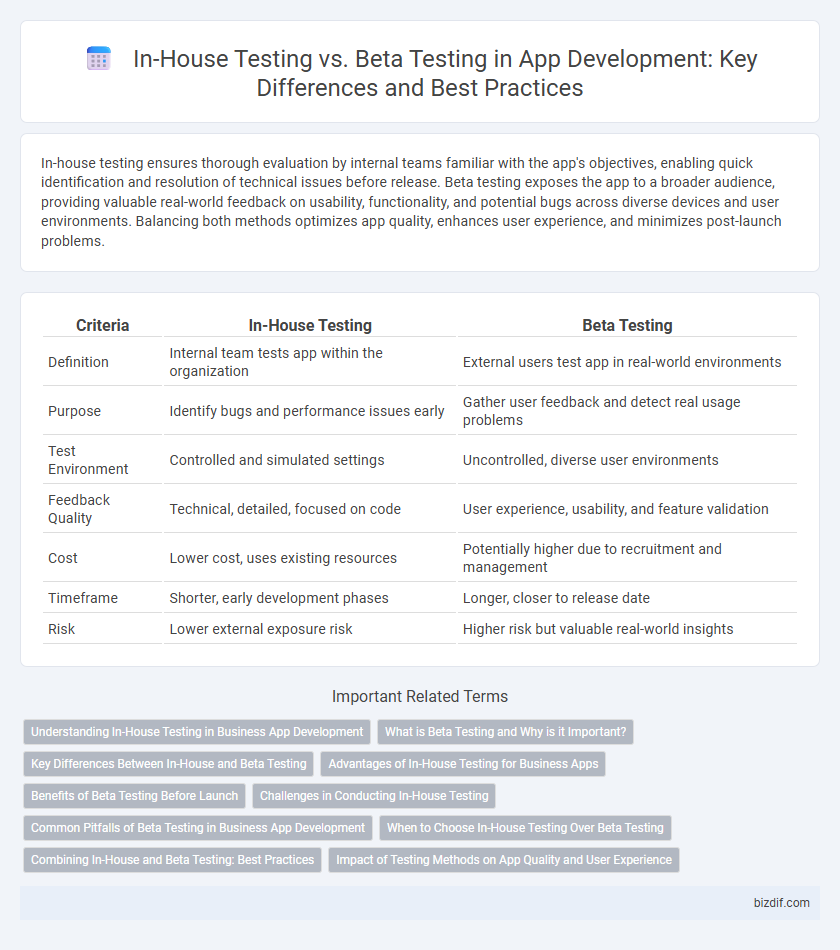In-house testing ensures thorough evaluation by internal teams familiar with the app's objectives, enabling quick identification and resolution of technical issues before release. Beta testing exposes the app to a broader audience, providing valuable real-world feedback on usability, functionality, and potential bugs across diverse devices and user environments. Balancing both methods optimizes app quality, enhances user experience, and minimizes post-launch problems.
Table of Comparison
| Criteria | In-House Testing | Beta Testing |
|---|---|---|
| Definition | Internal team tests app within the organization | External users test app in real-world environments |
| Purpose | Identify bugs and performance issues early | Gather user feedback and detect real usage problems |
| Test Environment | Controlled and simulated settings | Uncontrolled, diverse user environments |
| Feedback Quality | Technical, detailed, focused on code | User experience, usability, and feature validation |
| Cost | Lower cost, uses existing resources | Potentially higher due to recruitment and management |
| Timeframe | Shorter, early development phases | Longer, closer to release date |
| Risk | Lower external exposure risk | Higher risk but valuable real-world insights |
Understanding In-House Testing in Business App Development
In-house testing in business app development involves rigorous evaluation within the organization to ensure functionality, security, and performance meet internal standards before release. This controlled environment allows developers and QA teams to identify bugs and optimize user experience based on company-specific requirements. Prioritizing in-house testing reduces risks and improves app stability, laying a strong foundation prior to external beta testing phases.
What is Beta Testing and Why is it Important?
Beta testing involves releasing a pre-launch version of an app to a limited group of external users who provide real-world feedback on functionality, usability, and bugs. This phase is crucial for identifying issues that may not surface during in-house testing due to diverse environments and user behaviors. Incorporating beta testers' insights enhances app stability, user satisfaction, and helps ensure a successful launch in competitive app markets.
Key Differences Between In-House and Beta Testing
In-house testing involves internal team members rigorously evaluating the app for functionality, usability, and security within a controlled environment, ensuring immediate feedback and quick bug resolution. Beta testing engages a broader external audience, providing real-world usage insights, uncovering diverse device-specific issues, and gathering user experience data that internal testing might overlook. Key differences include testing scope, environment control, and feedback diversity, with in-house focusing on controlled, precise defect identification and beta testing emphasizing large-scale user interaction and performance validation.
Advantages of In-House Testing for Business Apps
In-house testing offers businesses rigorous control over the app development process, enabling early identification and resolution of bugs before external exposure. This method enhances data security by limiting access to proprietary information within the organization. Furthermore, close collaboration among internal teams during testing accelerates iterative improvements, optimizing functionality tailored specifically to business needs.
Benefits of Beta Testing Before Launch
Beta testing uncovers real-world user feedback and identifies bugs that internal teams might miss, enhancing app stability and performance across diverse devices. It provides critical insights into user experience, helping developers fine-tune features and UI to meet target audience expectations. Engaging external testers reduces post-launch risks and improves app reputation by addressing issues prior to public release.
Challenges in Conducting In-House Testing
In-house testing faces challenges such as limited tester diversity, which can lead to missed user interface issues and real-world scenario gaps. Resource constraints often result in insufficient testing time and coverage, impacting the identification of critical bugs. Moreover, internal biases may cause testers to overlook usability problems that external users could encounter.
Common Pitfalls of Beta Testing in Business App Development
Beta testing in business app development often faces pitfalls such as inadequate tester selection, leading to unrepresentative feedback that fails to capture real-world usage. Insufficient communication channels can result in developers missing critical bug reports, delaying issue resolution and affecting product quality. Furthermore, lack of clear testing objectives may cause scattered feedback, complicating prioritization of fixes before the official app launch.
When to Choose In-House Testing Over Beta Testing
In-house testing is ideal during early development stages when developers need to iteratively identify and fix core functional issues within a controlled environment. It allows for immediate feedback from internal teams who possess deep product knowledge, ensuring critical bugs are caught before external exposure. Choose in-house testing over beta testing when confidentiality, rapid iteration, and precise issue tracking are priorities before releasing the app to a broader user base.
Combining In-House and Beta Testing: Best Practices
Combining in-house and beta testing maximizes app development quality by leveraging controlled internal feedback alongside diverse real-world user insights. Establish clear testing objectives and timelines for both phases to ensure smooth transition and comprehensive coverage of functionality and usability. Utilize analytics and user feedback tools to prioritize bug fixes and feature improvements effectively before final release.
Impact of Testing Methods on App Quality and User Experience
In-house testing enables developers to identify and fix critical bugs early by leveraging controlled environments and specialized expertise, which enhances app stability and performance. Beta testing provides real-world user feedback from diverse devices and scenarios, uncovering usability issues and improving overall user experience. Combining both methods significantly boosts app quality, reducing crash rates and increasing user satisfaction post-launch.
In-House Testing vs Beta Testing Infographic

 bizdif.com
bizdif.com